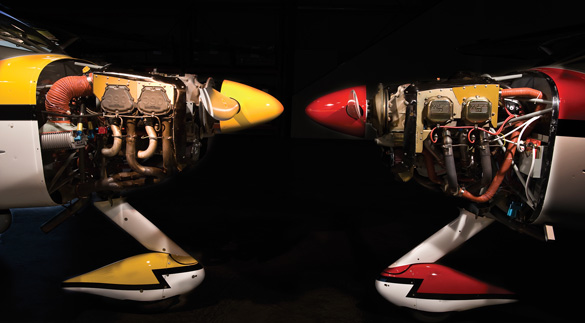
These are among the most challenging questions for prospective builders to answer: When you have the choice of several powerplants for a given design, do you go for the possible economy of the smaller engine or opt for max power? Are the benefits of a (surely) more expensive and (probably) heavier high-horsepower engine really worth the negative offsets? Do you, in the end, get what you pay for?
Engine-size creep is nothing new in aviation. Many popular designs started small and grew to accept big-time power—some handled it with aplomb, some, well…not so much.
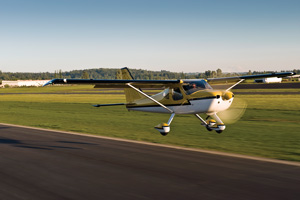
The GlaStar Sportsman exemplifies the concept. As the two-seat GlaStar, the design was intended to carry a 125-horsepower Continental IO-240, but was quickly adapted to have anything from a Lycoming O-235 (nominally 115 hp) to a Lycoming O-360 of 180 hp. When the larger Sportsman was developed, the plan was to raise its gross weight, improve its backwoods utility and create a larger cabin to make it a 2+2 (two adults and two kids). Such an airplane would be a doggy performer on 115 hp, so the baseline engine was the 180-hp Lycoming O-360; the first factory prototype was designed with this engine and performed well.
Then the Sportsman began acting like its brand name—gaining floats (amphibious and straight), large-wheel conventional gear and all the other trappings of a true back-country utility aircraft. With that shift came the calls for more power. At the outset of this discussion it could be inferred that there is some ideal power level for any given airframe, and for conventional operations that’s true. But when you’re dealing with short strips or flying from the water, there is no such thing as too much power. (OK, there probably is, but to cross that threshold will require serious effort.)
Glasair Aviation heeded the hollering by fitting the then-new IO-390 powerplant. I know; I was there as an about-to-be Sportsman builder, bullhorn in one hand and a shoehorn in the other. At the time, late 2005, the IO-390 was gaining popularity in the kitbuilt world, and because of aggressive pricing by Lycoming on the kit-engine components, it was substantially less expensive than the mechanically similar 200-hp IO-360. Fewer greenbacks, more pony tails—officially, to the tune of 10, though the angle-valve IO-360 is generally known to put out a bit less than the advertised 200 hp when strapped to a dyno—what’s not to like?
Since offering the IO-390 for the Sportsman airframe, Glasair Aviation has sold very few with the smaller 180-hp IO-360 engine. Even for builders with no intention of putting their aircraft on floats or dropping in on an Alaskan sandbar, the burly engine was the first and only choice. And yet there was always a bit of side discussion: Do you really need that big a powerplant for day-to-day use? Are we just falling into the bigger-is-better trap without really looking at the issues?
Side by Side
These remain valid questions, sometimes difficult to answer accurately. Homebuilts by nature are individual aircraft. Two seemingly similar examples can and often do have different performance and handling qualities, and it’s almost assured that each will be equipped to its builder’s whims and abilities. Making a direct comparison of two specific aircraft—one with a large engine and one with the smaller acceptable powerplant, for example—would be complicated by a host of other variables and leave us wondering if we’d measured the true performance difference or merely unit-to-unit variations.
Then something interesting happened. Glasair Aviation, which had built a factory demonstrator with the IO-360 engine (in this case from Superior), was in the process of creating a sister ship with a Lycoming-supplied IO-390. Both would be outfitted in roughly the same trim, and would enjoy the efforts of the same 74-inch Hartzell blended-airfoil propeller. Each example had come from Glasair Aviation’s Two Weeks to Taxi (TWTT) shop, and both would use the latest specification of doors, interiors, panels and accessories.
Here, then, were two aircraft almost identically equipped except for the lump between the firewall and the spinner backplate. Perfect.
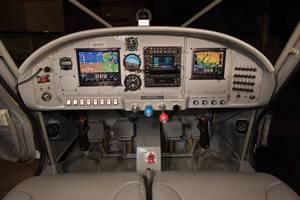
Preconceptions, Please Step Aside
Flying the comparison aircraft back to back on the same balmy late-May afternoon at the Glasair Aviation facility in Arlington, Washington, was the order of the day. I entered the comparison with an open mind, but not without some preconceptions. First, having lived with a 210-plus-horsepower Sportsman, I probably arrived with a built-in bias for more power—seldom (OK, make that never) have I wished for my airplane to have less grunt. Second, I had heard that the 180-hp airplane was nearly as fast, and actually more pleasant to fly because the engine is smoother, the cabin quieter and the handling better balanced; the IO-390 aircraft tends to be nose heavy. Contrasting points, then: A faster, brawnier version pitted against an overall more pleasant (less “beast” like) iteration.
Sounded like a fair fight to me.
We started the comparison randomly. It happened that the yellow IO-390 airplane was parked nearest the ramp, so Ted Setzer and I hopped in it first.
Would You Look at This?
Before we begin the back-to-back comparison flights, a word about the current Sportsman coming out of TWTT. For starters, the interior fit and finish are nothing short of amazing. A newly revised instrument panel continues to use a fiberglass shell with flat aluminum inserts, but the division between the pilot’s panel and the radio stack has been eliminated. (A similar panel is available in the aftermarket for Sportsman builders from Fiber Tech Composites.) As a result of this change, real estate for the primary instruments is now far more flexible.
In the current IFR iteration, the TWTT Sportsman employs an 8.4-inch-diagonal Advanced Flight Systems AF-3500 EFIS surrounded by a TruTrak DigiFlight II autopilot head on the left and steam-gauge backups on the right. N944SP, the factory’s IO-390-powered demonstrator, also had a Garmin GMA 340 audio panel, GPS 430W nav/com/GPS, SL40 second com and a GTX 327 transponder. Over on the right is an AF-3400 engine monitor. It’s possible to fit the engine monitor screen with its own ADAHRS unit for EFIS redundancy and, of course, data generated by either unit can be shown on both screens.
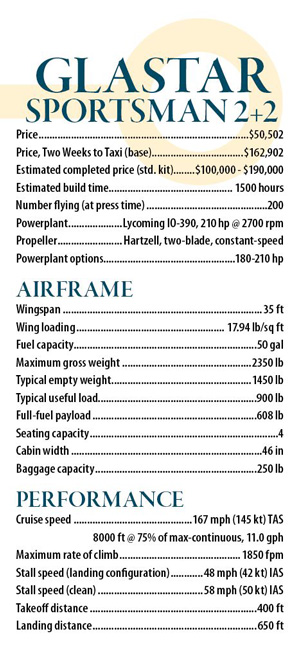
The seats have tall, slightly soft bottom cushions and nicely angled back pads; a new addition for the Sportsman line are seat backs that can be moved easily. (Currently, the seat backs adjust by moving two pins along a track, an operation that almost can’t be done while you’re sitting there.) As before, the seat bottoms do not adjust.
Even though N944SP is genuinely an Experimental aircraft, it packs very few nontraditional components. The IO-390 is exactly as delivered from Lycoming, fitted with a Precision Airmotive mechanical injection system and a pair of Slick magnetos.
Take a Test
Setzer and I flew the airplanes comparatively light but in the same configuration as one another. Cabin load was the two of us and absolutely minimal gear, fuel was full main tanks (30 gallons), for an estimated load of 570 pounds. The IO-390 airplane weighs 1489 pounds as presented, paint and everything. Against the standard maximum gross weight of 2350 pounds, we were 291 pounds under the limit and within a fraction of the forward loading limit.
Our first test was a standard short-field departure, using the traditional one notch of flaps and full power before brake release. The IO-390-powered Sportsman, spooled up and moving, has a gratifying rate of acceleration, breaking ground at 45 knots indicated (KIAS) in 8 seconds, using 400 feet of runway. We allowed the airplane to climb at full power/full-rich mixture through 600 feet MSL, where the flaps were retracted so that it could be in a stabilized climb when passing through 1000 feet MSL. At 90 KIAS, the yellow Sportsman was showing just shy of 1000 fpm in the climb. A measurement taken by our calibrated sound-pressure meter held between the pilots showed 100.3 dbA.
Although the accuracy of electronic instruments is much better than with steam gauges, we allowed the digital voice recorder to time-stamp passage of altitude. From 1000 feet MSL to 4000 feet MSL, the climb took 3:01, for an average of 995 fpm; the Advanced Flight EFIS was showing 1000 fpm most of the way up. We’ll call that pretty close. Also note that our climb data came at 90 KIAS, a compromise speed. Best rate of climb is 85 KIAS, while the recommended cruise climb is near 100 KIAS. Best angle is 75 KIAS. By choosing 90 KIAS, we gave up absolute climb rate for better visibility and engine cooling.
Fuel flows during the climb started at 19.4 gph but tapered to 18.3 at 4000 feet MSL. For the second half of the climb, we reduced engine speed to 2500 rpm and leaned the mixture slightly to get 14.7 gph. Maintaining 800 fpm from 5000 feet MSL to our target of 6500 feet MSL, the Sportsman soon arrived at the cruise-test altitude. On this day 6500 feet MSL, alongside an outside air temp of 58 F, gave us a density altitude of 7920 feet. We’ll call that our 8000-foot data hack, if you don’t mind.
Our first cruise test was to try a high power setting, so we left the prop at 2500 rpm, the throttle full in, and leaned to 50 rich of peak EGT. Fuel flow was an indicated 11.2 gph. According to the Lycoming engine charts, this is a power setting of 70%, which will explain why our test data doesn’t agree exactly with the factory’s max-cruise estimates.
To eliminate pitot-static and instrument errors, we ran three legs 120 apart and noted the groundspeed. When later crunched, true airspeed was 143 knots. The calculated TAS based on the EFIS was 142 knots. A sound check had the cabin noise at 97.6 dbA.
For the next test, the prop was reset to 2400 rpm and the mixture to peak EGT, resulting in a 9.4 gph fuel burn. The three-way GPS run disclosed 135 knots true. That’s not bad economy: 16.5 statute miles per gallon at economy cruise, and just a bit more—14.6 smpg—at the higher power setting. How many of you with SUVs or pickups don’t get that kind of mileage?
With the basic performance numbers obtained, Setzer and I returned to Arlington for a crosswind landing on Runway 34; the wind was favoring 29, but we wanted to minimize the time on the ground.
Subjectively, the factory IO-390 Sportsman felt, well, nicer and newer than my 500-hour-old example. It’s hard to pin it down. The controls were slightly tighter and overall N944SP simply seemed a fresher, more detailed airplane than mine. Sigh.
On the descent and landing, Glasair Aviation’s yellow machine performed exactly as mine does, with ample rudder authority, very good pitch response and positive stability, and slightly heavy (if effective) ailerons. A short approach with the speed pegged at 65 KIAS crossing the fence led to a pleasing arrival. Had Setzer been able to move his left leg out of the way fast enough, I could have held the downwind (right) wing up much further into the landing roll.

Switching Gears
The same test procedure was repeated immediately after, using the factory’s red IO-360-powered Sportsman. According to the time stamp on the digital recorder, we were off in the second aircraft within 20 minutes of landing the first. Again, the test conditions were about as similar as we could hope for. The IO-360 airplane is 38 pounds lighter, so our laden weight was 329 pounds shy of the 2350 max gross—we had the same cabin load and full main tanks. To no one’s surprise, the 180-hp airplane took longer to accelerate to 45 KIAS—12 seconds versus 8—and consumed 150 feet of additional runway before reaching rotation speed. Even so, a ground roll of 550 feet with no special effort beyond applying full power before brake release is a very good figure.
Repeating the climb test, we retracted the flaps at 600 feet MSL and allowed the airplane to stabilize at 90 KIAS as it passed through 1000 feet MSL. Timing the climb from 1000 to 4000 feet MSL at 3:27 yielded an average rate of 870 fpm. That’s 125 fpm less than the IO-390. By 4000 feet MSL, the IO-360’s fuel flow was down to 15 gph at 2700 rpm and full throttle. By reducing to the cruise climb state, full throttle and 2500 rpm, the fuel flow came down to 13.6 gph with the hottest cylinder now 386 F.
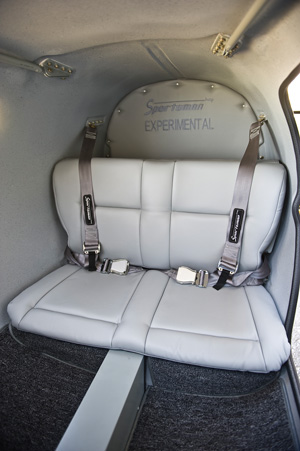
As the 180-horse airplane leveled off at 6500 feet MSL, I had a chance to make a subjective comparison of engine/airframe smoothness. I’d been led to believe that the 360 was wonderfully smooth, while the 390 is more raucous, rumbly. Well, if that’s the case, I didn’t perceive it. In terms of the seat-of-the-pants feel, the 360 is not appreciably smoother than the 390. I was expecting to feel a difference, but the apparent vibration levels are so similar that it would take objective measurement to know for sure. Setzer agreed with me.
Cruising Along in the 180
The outside-air temp hadn’t changed between the flights, so 6500 feet MSL remained close to 8000 feet density altitude. Mixture set to 50 rich of peak, the fuel flow settled on 9.6 gph. Running the three-way wind triangle netted 137 knots true—precisely what the Advanced Flight EFIS was calculating, which is a good sign for this airplane’s pitot-static calibration.
The 6-knot differential from the IO-390 ship came at a substantial fuel flow difference of 2.5 gph, which allowed the 180 to post a respectable 16.4 smpg figure at this power setting and fuel flow. Next on the test card was running at 2400 rpm and peak EGT. Unfortunately, the 180-horse airplane’s vernier mixture control had a bad ramp or a dented ball, because despite trying for 10 minutes to accurately set peak EGT, we just couldn’t do it. The control could be moved to the right setting, but wouldn’t hold it; the sweet spot just wasn’t to be found.
There’s an interesting parallel in the performance. Our tests proved something we’ve seen before when flying the IO-390 and IO-360 ships side by side. At equivalent airspeeds, the 390 consumes the same or even slightly less fuel per hour. That fact doesn’t make sense when you look at just the displacement and power differences, but the IO-390 has both more compression ratio (8.9 versus 8.5:1) and slightly more efficient combustion chambers, and the two together improve the engine’s basic efficiency.
The lighter IO-360 benefits the Sportsman’s handling, but only marginally. It’s obvious to someone with recent time in both that the 390 is more nose heavy. It’s not negatively so; there’s enough up-elevator trim at the forward edge of the weight-and-balance envelope to comfortably trim for a short-field approach, and sufficient elevator to hoist the nose for landing. But the IO-360 airplane is ever so slightly nicer in this regard, better balanced, a bit lighter to the touch.
Calculating the Costs
There is little question the IO-390 will cost more. In the case of the Sportsman TWTT program, the engine is an approximately $8000 upgrade from the fuel-injected 360-cube model. If you’re comparing prices outside this program, the margin is thinner. Current list price for a Lycoming Thunderbolt IO-360-M1A is $29,100; the IO-390-X lists for $32,650. But that’s one source. Lycoming has recently increased the cost of the kit components for the IO-390, so outside shops have difficulty meeting that price, while there are still avenues to build an aftermarket IO-360 for less than $29K. Also, there are overhauled options for the 360 customer. Fact is, there aren’t any yet for the 390.
Ongoing expenses will also be higher with the IO-390. It’ll be more dough to overhaul than the IO-360, and will likely consume more fuel day to day—how much depends on your mixture management skills and proclivities. With balanced injectors, both engines will run happily lean of peak EGT.
Surprise Ending
Going into the comparison, I thought the IO-390 would trounce the 360 on performance—I had in mind top-fuel dragster tearing away from a cautiously driven Toyota Prius.
Wrong. Performance-wise, the benefits of the big-inch engine are less than I thought, though the 390-powered aircraft most definitely comes off the runway faster. If you are planning to put your Sportsman on floats or big tires, you have your answer right there. Skim the order form if you want, just be sure to check the box next to “IO-390 upgrade.” Likewise, if you routinely operate from short strips at high density altitudes, the larger engine will buy you more than peace of mind; it could be the difference between getting out cleanly and departing with a few twigs in the wheelpants.
For the rest of you, it’s a tougher decision to make, complicated by the proximity of performance between the two options. The IO-360 is a proven package, provides surprisingly good performance in the Sportsman, and will save a buck or two here and there during your ownership of the airplane, especially if you installed an overhauled unit. The happy ending—there is one this time around—is that both engines are great options for this airframe. The Sportsman seems utterly contented with either.
Perhaps the final word has already been uttered. Virtually all of the TWTT Sportsmans to trundle out the door have done so to an IO-390 soundtrack.
For more information, call 360-435-8533 or visit www.glasairaviation.com.

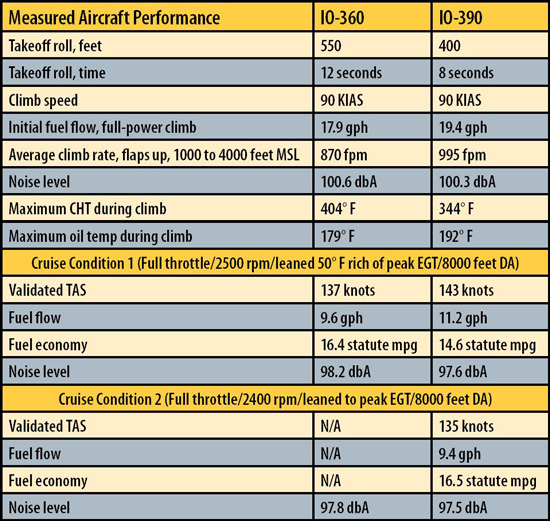
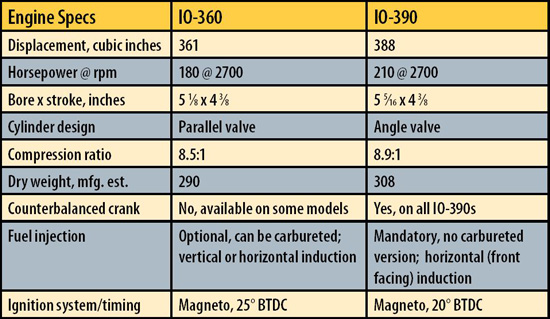









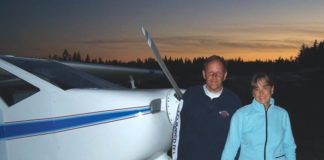
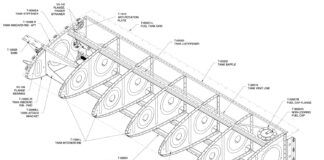
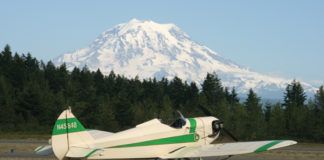

This article is as true now 10 years later as it was when it was written. Excellent work and something anyone considering a Sportsman should read!
I would be curious to a comparative test between the Adept base model at 260hp , 306lb and 195 cu inch and a Lycoming 540 also rated at 260hp but coming in at 400lb and 540 cubic inch .
The Adept is almost 100lb lighter , physically smaller and being designed with modern technology is also more economical .
Now that would interest me .
It would interest us as well.